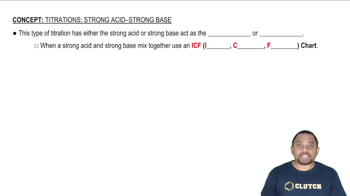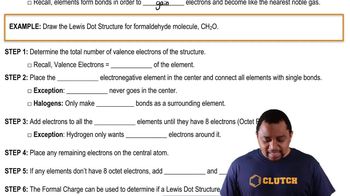Write net ionic equations for the reactions that take place when aqueous solutions of the following substances are mixed: a. sodium cyanide and nitric acid b. ammonium chloride and sodium hydroxide c. sodium cyanide and ammonium bromide d. potassium hydrogen sulfate and lithium acetate e. sodium hypochlorite and ammonia
Ch.16 - Acids and Bases

Chapter 16, Problem 140d
Determine the pH of each two-component solution. d. 0.088 M HClO4 and 0.022 M KOH
 Verified step by step guidance
Verified step by step guidance1
Identify the nature of the substances: HClO4 is a strong acid and KOH is a strong base.
Write the balanced chemical equation for the reaction: \( \text{HClO}_4 + \text{KOH} \rightarrow \text{KClO}_4 + \text{H}_2\text{O} \).
Calculate the moles of HClO4 and KOH using their concentrations and the volume of the solution (assuming 1 L for simplicity).
Determine the limiting reactant by comparing the moles of HClO4 and KOH.
Calculate the concentration of excess HClO4 or KOH after the reaction, and use it to find the pH or pOH, then convert to pH if necessary.

Verified video answer for a similar problem:
This video solution was recommended by our tutors as helpful for the problem above.
Video duration:
4mWas this helpful?
Key Concepts
Here are the essential concepts you must grasp in order to answer the question correctly.
pH Scale
The pH scale measures the acidity or basicity of a solution, ranging from 0 to 14. A pH of 7 is neutral, below 7 indicates acidity, and above 7 indicates basicity. The scale is logarithmic, meaning each whole number change represents a tenfold change in hydrogen ion concentration. Understanding pH is crucial for analyzing the behavior of acids and bases in solution.
Recommended video:
Guided course

The pH Scale
Strong Acids and Bases
Strong acids, like HClO4, completely dissociate in water, releasing all their hydrogen ions (H+), while strong bases, like KOH, fully dissociate to release hydroxide ions (OH-). This complete dissociation simplifies calculations of pH, as the concentration of the acid or base directly determines the concentration of H+ or OH- ions in the solution. Recognizing the strength of acids and bases is essential for accurate pH determination.
Recommended video:
Guided course

Strong Acid-Strong Base Titration
Neutralization Reaction
A neutralization reaction occurs when an acid reacts with a base to form water and a salt, typically resulting in a solution that is closer to neutral pH. In this case, the H+ ions from HClO4 will react with the OH- ions from KOH. The extent of this reaction influences the final pH of the solution, making it important to consider the stoichiometry of the reactants involved.
Recommended video:
Guided course

Lewis Dot Structures: Neutral Compounds
Related Practice
Textbook Question
Textbook Question
Morphine has the formula C17H19NO3. It is a base and accepts one proton per molecule. It is isolated from opium. A 0.682-g sample of opium is found to require 8.92 mL of a 0.0116 M solution of sulfuric acid for neutralization. Assuming that morphine is the only acid or base present in opium, calculate the percent morphine in the sample of opium.
Textbook Question
The pH of a 1.00 M solution of urea, a weak organic base, is 7.050. Calculate the Ka of protonated urea.
